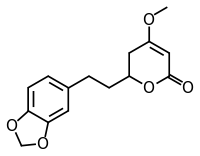Dihydromethysticin
 | |
| Names | |
|---|---|
| IUPAC name
(2S)-2-[2-(1,3-benzodioxol-5-yl)ethyl]-4-methoxy-2,3-dihydropyran-6-one | |
| Identifiers | |
| 19902-91-1 | |
| Jmol-3D images | Image |
| PubChem | 88308 |
| |
| Properties | |
| C15H16O5 | |
| Molar mass | 276.28 g/mol |
| Except where noted otherwise, data is given for materials in their standard state (at 25 °C (77 °F), 100 kPa) | |
| | |
| Infobox references | |
Dihydromethysticin is one of the six major kavalactones found in the kava plant.[1]
Pharmacology
Dihydromethysticin has marked activity on the induction of CYP3A23, as does the related chemical desmethoxyyangonin.[2]
Both dihydromethysticin and methysticin induce the hepatic enzyme CYP1A1, which increases the amount of the very highly carcinogenic benzo[a]pyrene-7,8-dihydrodiol-9,10-epoxide in the body (via the metabolism of benzo[a]pyrene) and may be responsible for some of the toxic effects associated with kava consumption.
pyrene_metabolism.svg.png)
Metabolism of benzo[a]pyrene yielding the carcinogenic benzo[a]pyren-7,8-dihydrodiol-9,10-epoxide.
In vitro, dihydromethysticin possesses analgesic, anticonvulsant, and anxiolytic effects.[3] It has been found to act as a GABAA receptor positive allosteric modulator and as an reversible inhibitor of monoamine oxidase B.[4][5]
References
- ↑ Malani, Joji (2002-12-03). "Evaluation of the effects of Kava on the Liver" (PDF). Fiji School of Medicine. Retrieved 2009-09-04.
- ↑ Ma, Yuzhong; Karuna Sachdeva; Jirong Liu1; Michael Ford; Dongfang Yang; Ikhlas Khan; Clinton Chichester; Bingfang Yan (November 2004). "Desmethoxyyangonin and dihydromethysticin are two major pharmacological kavalactones with marked activity on the induction of CYP3A23.". Drug Metabolism and Disposition 32 (11): 1317–1324. doi:10.1124/dmd.104.000786. PMID 15282211.
- ↑ Walden J, von Wegerer J, Winter U, Berger M, Grunze H (May 1997). "Effects of kawain and dihydromethysticin on field potential changes in the hippocampus.". Progress in Neuro-psychopharmacology and Biological Psychiatry 21 (4): 697–706. doi:10.1016/s0278-5846(97)00042-0. PMID 9194150.
- ↑ Sarris J, LaPorte E, Schweitzer I (2011). "Kava: a comprehensive review of efficacy, safety, and psychopharmacology". Aust N Z J Psychiatry 45 (1): 27–35. doi:10.3109/00048674.2010.522554. PMID 21073405.
- ↑ Singh YN, Singh NN (2002). "Therapeutic potential of kava in the treatment of anxiety disorders". CNS Drugs 16 (11): 731–43. doi:10.2165/00023210-200216110-00002. PMID 12383029.
| ||||||||||||||||
| ||||||||||||||||||||||||||||||||||||||||||||||||||||||||||||||||||||||||||||||||||||||||||||||||||||||